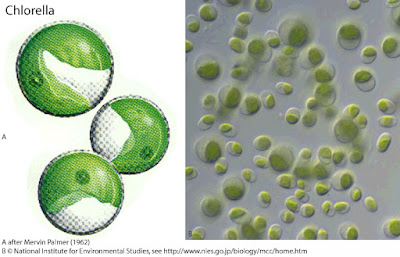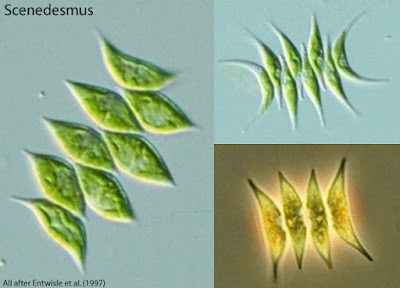Run your car on the latest green energy. Just one question, algal foam or flask?
If we covered Wales in algal ponds or various oddly shaped growth chambers, we could generate enough fuel to run about half the UK transport system. Actually we'd probably need to throw in North Yorkshire or one of the other larger English counties as well.
More precise figures were presented at today's session of the British Phycological Society meeting in Newcastle. To run the whole of the UK transport system requires about 60 million 'tonnes equivalent' of oil annually, with 40% from diesel. Assuming I transcribed correctly, to replace the diesel component with algal biodiesel you'd need about 2.4 million hectares, or 10%, of the UK land area. You can compare this with an earlier blog I did on this topic which used Portugal to fuel the rest of Europe...
And algae are more efficient than more familiar energy crops such as oilseed and Jatropha. Chlorella (illustrated here) can give you 10 of these 'Mte's per hectare per year, way above that of oilseed at 1.5 and Jatropha at 2.4.
Christopher Howe from Cambridge University (see Howe Lab) made it clear that headlines like 'Gold rush for algae' and 'Algae to solve the Pentagon's jet fuel problem' were overstating things a little, but there is definitely room for algae in our future energy mix.
Since 2007 over US$1 billion has been invested in algal fuel technology. And with good reason. Algae don't have to compete with crop plants for agricultural land (although I admit covering Wales and Yorkshire with algae would be a little competitive) and could grow in seawater or waste water (so could be well clear of habitable and arable land...). They might also sequester carbon or at least 'borrow it' on the way through the process giving you more energy bang for your carbon buck!
Even with all the research done to date the areas needed are too large and the profit margins too small (basically because petrol is too cheap, but that's another story). So Howe is looking at different ways to turn algae into energy, such as using it directly for electricity rather than to produce liquid fuel. He gave a fascinating talk about how hydrogen fuel cells, being developed to run cars off liquid hydrogen, could be converted to algal fuel cells.
He started by creating microbial fuel cells, with hydrogen fuel being replaced with glucose and heterotrophic microorganisms (ones that live like us rather than generate their own sugars like plants and algae) that would oxidise the glucose. It's all about electrons and protons moving through the system, and I won't (and can't) go into that detail.
Howe then decided to cut out the middle man and used photosynthetic organism (things with the ability to convert sunlight to sugars) and created what is known as a biophotovoltaic device (BPVs, or photosynthetic microbial fuel cell). Essentially it is water and light in, water and energy out - again I'll leave out the bit with electrons and photons...
It is all coming along nicely and his research group has now moved on to growing biofilms (living films of organisms) on electrodes - things like the green algae Chlorella and Dunalliella, and the blue-green bacterium Synechocystis. With or without the films there is some activity in the dark as well, presumably due to these organisms processing some of their fixed carbon, offering some potential for storing power for those long winter nights when you want to nip out to the shops in your algal powered car.
The next steps are to combine a number of these units, modifying for hydrogen production if that is still preferred, coupling to desalinisation plant or even using plants in addition to algae (he tried out some mosses from the top of their university bike shed). Way in the future we could even have floating algal systems ('lily pads') out at sea.
[OK, a short break in this rather long blog, with a picture of Newcastle, where the algal meeting was held.]
Part two...
Gary Caldwell from Newcastle University is sticking with the fuel idea, and reckons we can do it much more efficiently with a little research and a little help from engineers. The latter, he says, are pragmatic and come up with novel approaches.
No matter what system you use to grow algae - open ponds or closed vessels - the big production cost (about 30% of total process) is in what is poetically called dewatering.
Algae tend to grow in concentrations between 0.3 and 5 g per litre, at best. They are very small - mostly 5-50 um in diameter (an um is a poor abbreviation for a micrometre, a one thousandth of a millimetre). And they have an electronegative charge which helps to keep them in a stable suspension.
At the moment dewatering is achieved mostly through spinning the culture round quickly (centrifugal recovery), which is energy intensive and expensive; adding chemicals to make the cells group together and separate out from the water (flocculation), which is time
consuming and needs lots of space), or filtering it, which only works for larger algae and can be expensive when filters get clogged.
Caldwell's group is keen on what is called flotation or foam fractionation. Fine air bubbles are pushed through the solution, rising up through culture attracting algae on the way. The algae or algal foam is then skimmed off the top. One of the main test organisms was the green alga Scenedesmus, pictured here.
The engineers came in handy when Caldwell realised he would need 960 litres of alga to test out his ideas thoroughly. Instead he used a sequential (or fractional factorial) experimental
approach, without needing so many replicates, on the advice of his engineer friends.
Anyway the results looked good. We were told "don't worry
about all these numbers" and there is a "great injustice in summarising in single
graph", but we can blame that on the engineers.
It turns out the concentration of
surfactant (the stuff that brings the algae and water droplets together) is the most important factor in optimising this system. Caldwell tried 'wet' and 'dry' foams, with the dry ones carrying (as you'd expect) less water, which
is good! So less surfactant is good.
Larger column
heights or lower surfactant concentrations allow for longer foam residence
times - which is also good.
The bubble size also turns out to be important. Caldwell said that by trying to make very tiny bubbles, which then attract more algae, his team was "playing around with the laws of physics". It seems University of Sheffield have good system for making bubbles and he used their microbubble generators or 'sparger'.
He explained the microbubble generator as being like a cheese grater, using alternating current to sheer off the bubbles, taking them from the normal range of 2 mm in diameter down to 0.4 mm. This doubled the concentration of algae extracted.
When you put the right surfactant into the flask, with the right sized bubbles, you get a lovely green foam
spewing out of the top. Very attractive to watch said Caldwell, but you can't
get too close or you might get covered in algae.
He mentioned that John Crave, while filming for a BBC1 Country File story, thought the foam looks tasty and dipped his finger in then licked it. Apparently it has an "interesting after taste". Generally one is advised to eat or drink surfactants and indeed unknown algal mixtures, but I gather John Crave (pictured below) is still presenting.
Caldwell's talk finished up with detail on getting the optimal harvesting time and lipid content - lipids are the oils we want to extract. He also found that this froth technique could be used to selectively harvest algae, testing it with the two algae illustrated in this blog and getting more of the Scenedesmus.
The next steps for Caldwell's team are to try a pulse injector system for the sufactant, a different collection cup to avoid wastage when the froth bubbles over and eventually carbon dioxide rather than compressed air injection.
It seems that algae may well end up inside your car. The question is whether you will be burning oil extracted from algal foam, or have a little growth chamber in the back seat extracting energy as you need it. Either way, it's green (algal) energy.





Comments